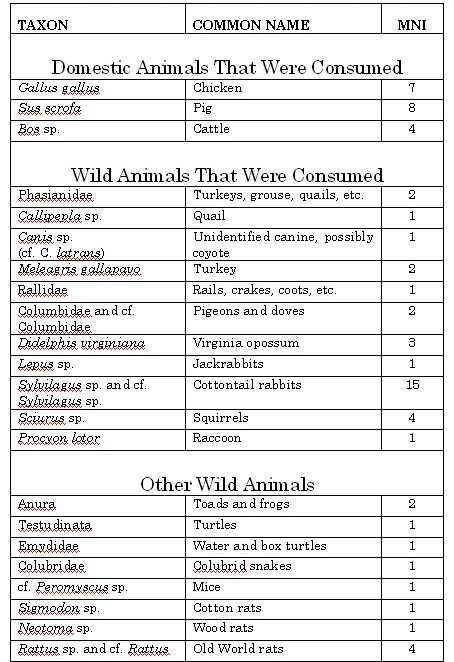
This summary of animal bones recovered from the farmstead lists the minimum number of individuals (MNI) for each species. Collectively, the entire faunal assemblage consists of 2,881 bones, and the analysis of these remains reveals some interesting things about the wild and domestic animals that were consumed by the family. The mix of wild and domestic animals is what should be expected on a nineteenth-century farmstead in central Texas. Three domestic animals-chickens, pigs, and cows-are well represented, and some of their remains have distinctive cutting, chopping, and sawing marks made by metal butchering tools. Many of the pigs and cows were slaughtered and consumed before reaching full maturity, perhaps indicating that the Williams family preferred eating tender meat from younger animals. But it could also indicate that the larger mature animals were sold for cash rather than being consumed on the farm.
The indigenous animals in the collection represent a variety of species that were most likely consumed as food sources. These include small birds, such as dove, quail, turkey, and an unidentified quail-sized bird, and small mammals such as rabbits, squirrels, and opossums. Rabbits must have been a favorite game animal because they have the highest MNI and the highest number of butchered bones. In contrast, the bones of small rodents, amphibians, and reptiles probably do not represent food sources. Snakes, turtles, rats, and mice could have been eaten, but they might also have been dispatched as vermin or perhaps died naturally after crawling under the house or into the trash midden.
It is notable that several fishhooks were recovered from the site, but no fish bones were found. However, two types of fish scales were recovered from flotation of the sediment from the subfloor storage pit, and these are from some type of bony fish and the Centrarchidae family that includes sunfish, blackbass, and crappies.
Several wild species that one might expect to see in a central Texas historic archeological assemblage are missing, especially large game birds such as ducks, geese, and most notably, white tailed deer. Deer would have been the largest indigenous animal native to the area, but their bones are completely absent in the faunal assemblage. In the late nineteenth century, white tailed deer were hunted so intensively that populations dwindled all across Texas. It may be that deer were exceedingly scarce around the Williams farmstead, possibly to the point that they seldom hunted deer. It is also interesting that no remains of dogs or horses/mules were found. We know that they kept many horses and mules, and most farm families had dogs as well. But the absence of these animals in the faunal assemblage is not totally unexpected since the remains of domestic dogs and horses would not have entered the archeological record in the same way that bones of butchered animals did.